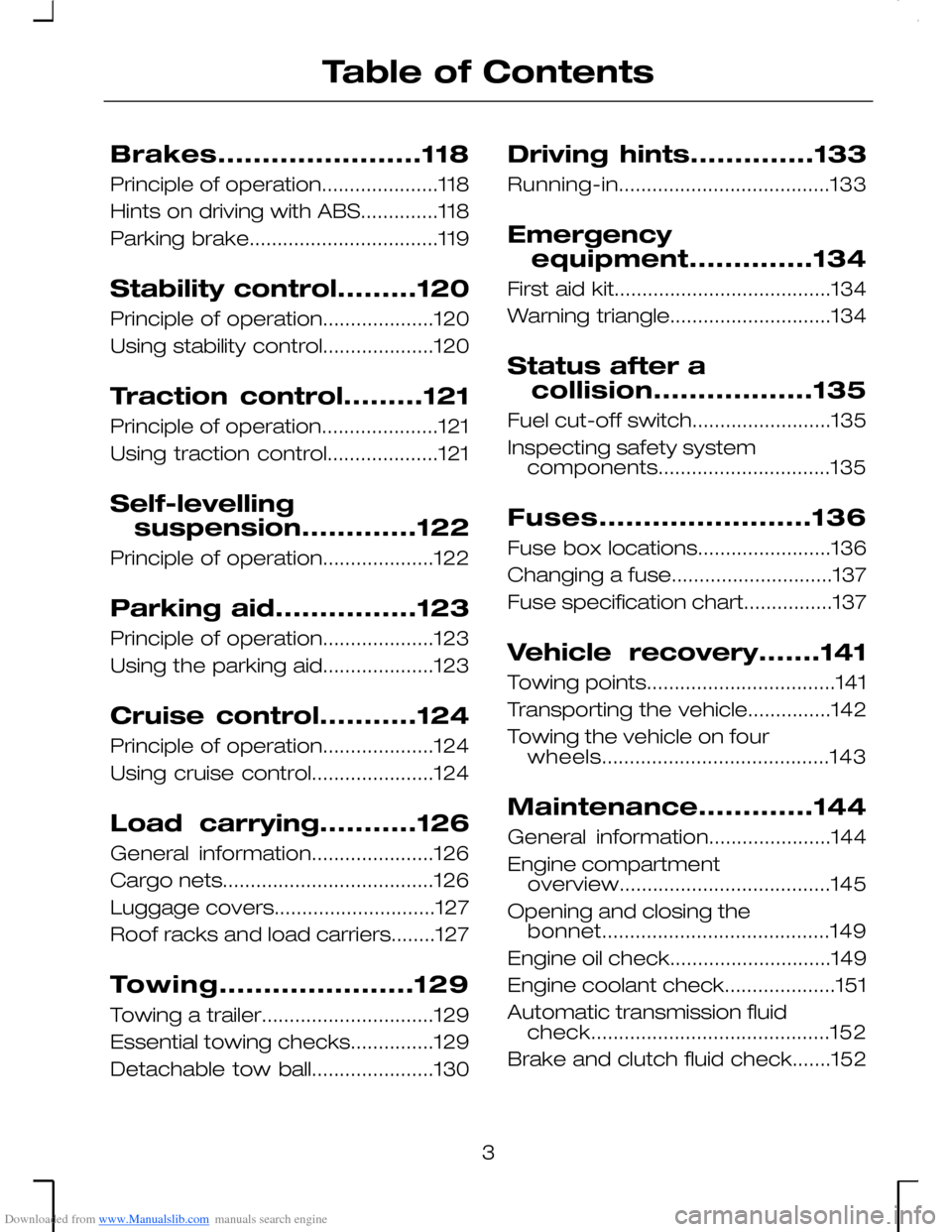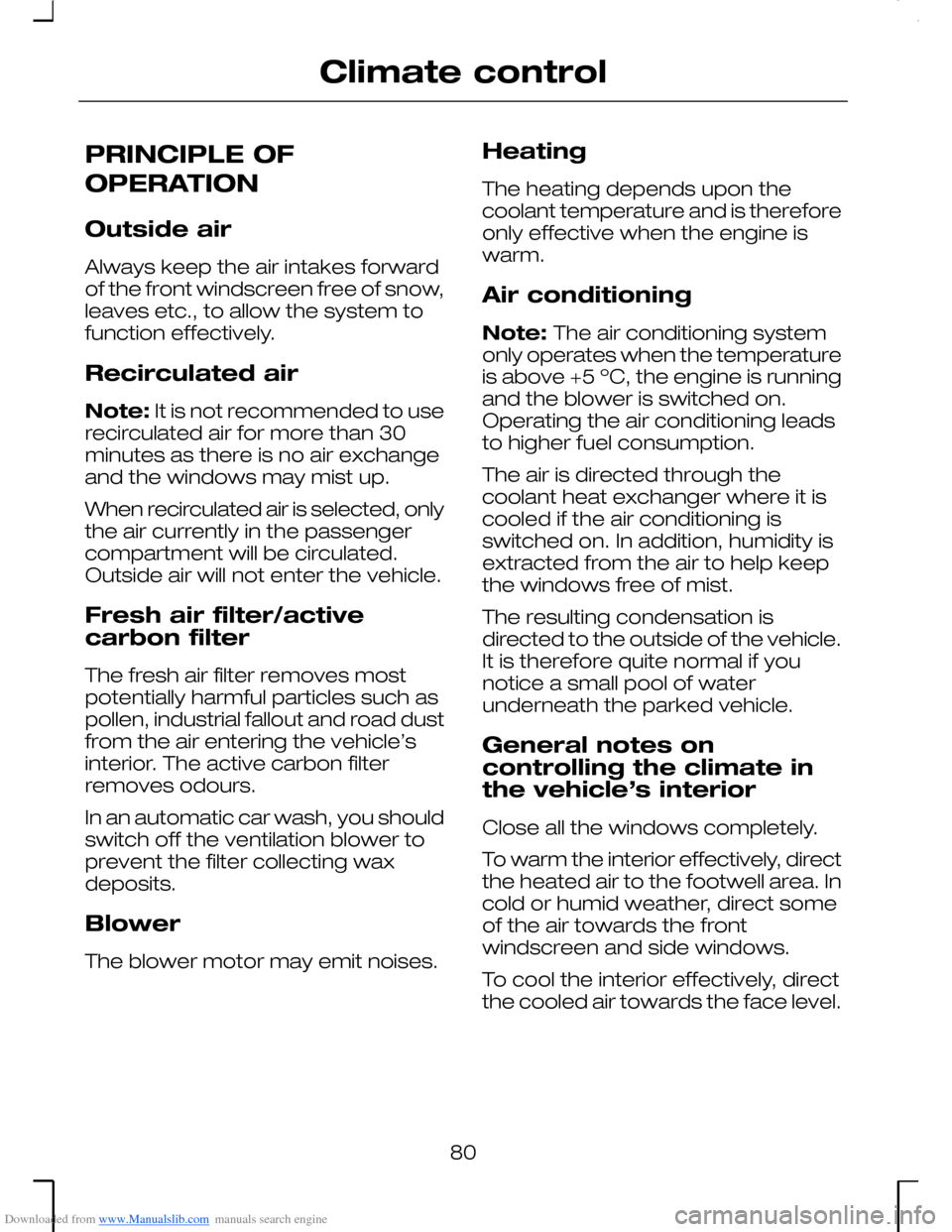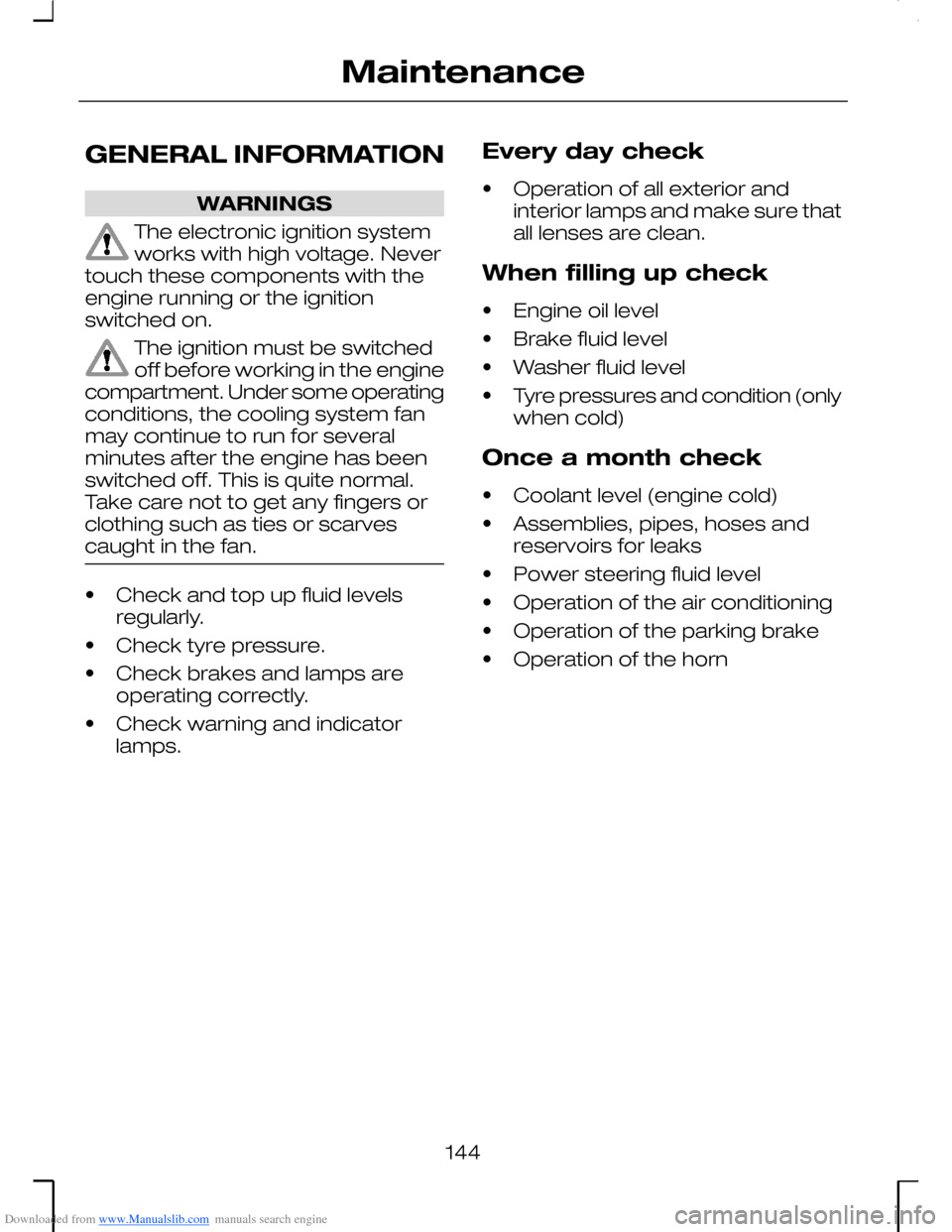Page 5 of 198

Downloaded from www.Manualslib.com manuals search engine Brakes.......................118
Principle of operation.....................118
Hints on driving with ABS..............118
Parking brake..................................119
Stability control.........120
Principle of operation....................120
Using stability control....................120
Traction control.........121
Principle of operation.....................121
Using traction control....................121
Self-levelling
suspension.............122
Principle of operation....................122
Parking aid................123
Principle of operation....................123
Using the parking aid....................123
Cruise control...........124
Principle of operation....................124
Using cruise control......................124
Load carrying...........126
General information......................126
Cargo nets......................................126
Luggage covers.............................127
Roof racks and load carriers........127
Towing......................129
Towing a trailer...............................129
Essential towing checks...............129
Detachable tow ball......................130
Driving hints..............133
Running-in......................................133
Emergency
equipment..............134
First aid kit.......................................134
Warning triangle.............................134
Status after a
collision..................135
Fuel cut-off switch.........................135
Inspecting safety systemcomponents...............................135
Fuses........................136
Fuse box locations........................136
Changing a fuse.............................137
Fuse specification chart................137
Vehicle recovery.......141
Towing points..................................141
Transporting the vehicle...............142
Towing the vehicle on fourwheels.........................................143
Maintenance.............144
General information......................144
Engine compartmentoverview......................................145
Opening and closing thebonnet.........................................149
Engine oil check.............................149
Engine coolant check....................151
Automatic transmission fluidcheck...........................................152
Brake and clutch fluid check.......152
3
Table of Contents
Page 74 of 198
Downloaded from www.Manualslib.com manuals search engine GAUGES
Engine coolant temperature gaugeA
TachometerB
SpeedometerC
Fuel gaugeD
Tripmeter reset buttonE
Odometer and tripmeterF
Information displayG
Trip computer reset buttonH
Engine coolant temperaturegauge
At normal operating temperature, theneedle remains within the centresection.
If the needle enters the red section,the engine is overheating. Switch offthe ignition and determine the sourceof the problem once the engine hascooled down.
72
InstrumentsE70433
Page 82 of 198

Downloaded from www.Manualslib.com manuals search engine PRINCIPLE OF
OPERATION
Outside air
Always keep the air intakes forwardof the front windscreen free of snow,leaves etc., to allow the system tofunction effectively.
Recirculated air
Note: It is not recommended to userecirculated air for more than 30minutes as there is no air exchangeand the windows may mist up.
When recirculated air is selected, onlythe air currently in the passengercompartment will be circulated.Outside air will not enter the vehicle.
Fresh air filter/activecarbon filter
The fresh air filter removes mostpotentially harmful particles such aspollen, industrial fallout and road dustfrom the air entering the vehicle’sinterior. The active carbon filterremoves odours.
In an automatic car wash, you shouldswitch off the ventilation blower toprevent the filter collecting waxdeposits.
Blower
The blower motor may emit noises.
Heating
The heating depends upon thecoolant temperature and is thereforeonly effective when the engine iswarm.
Air conditioning
Note: The air conditioning systemonly operates when the temperatureis above +5 ºC, the engine is runningand the blower is switched on.Operating the air conditioning leadsto higher fuel consumption.
The air is directed through thecoolant heat exchanger where it iscooled if the air conditioning isswitched on. In addition, humidity isextracted from the air to help keepthe windows free of mist.
The resulting condensation isdirected to the outside of the vehicle.It is therefore quite normal if younotice a small pool of waterunderneath the parked vehicle.
General notes oncontrolling the climate inthe vehicle’s interior
Close all the windows completely.
To warm the interior effectively, directthe heated air to the footwell area. Incold or humid weather, direct someof the air towards the frontwindscreen and side windows.
To cool the interior effectively, directthe cooled air towards the face level.
80
Climate control
Page 89 of 198

Downloaded from www.Manualslib.com manuals search engine AUXILIARY HEATER
The auxiliary heater aids in warmingthe engine and the interiorcompartment. It is integrated into thecooling system and is automaticallyswitched on or off depending uponthe coolant temperature.
It is possible that when theprogrammable auxiliary heater isactivated, exhaust fumes may comefrom under the sides of the vehicle.This is normal.
ELECTRIC SUNROOF
WARNING
Before operating the electricsunroof you should verify it isfree of obstructions and ensure thatchildren and/or pets are not in theproximity of the sunroof opening.Failure to do so could result in seriouspersonal injury. It is the primaryresponsibility of the supervising adultsto never leave a child unattended ina vehicle and to never leave the keysin an unattended vehicle.
Note: When the switches areoperated often during a short periodof time, the system might becomeinoperable for a certain time toprevent damage due to overheating.
Note: The electric sunroof isconnected to the vehicle’s globalopening and closing feature. SeeGlobal opening and closing (page 40).
There are two ways of opening thesunroof – the rear of the sunroof liftsopen or the sunroof opens from thefront, sliding back under the roof. Thesunroof opens and closes whilst theswitch is pressed.
Switch on the ignition to operate theelectric sunroof.
87
Climate controlE72187
Page 146 of 198

Downloaded from www.Manualslib.com manuals search engine GENERAL INFORMATION
WARNINGS
The electronic ignition systemworks with high voltage. Nevertouch these components with theengine running or the ignitionswitched on.
The ignition must be switchedoff before working in the enginecompartment. Under some operatingconditions, the cooling system fanmay continue to run for severalminutes after the engine has beenswitched off. This is quite normal.Take care not to get any fingers orclothing such as ties or scarvescaught in the fan.
•Check and top up fluid levelsregularly.
•Check tyre pressure.
•Check brakes and lamps areoperating correctly.
•Check warning and indicatorlamps.
Every day check
•Operation of all exterior andinterior lamps and make sure thatall lenses are clean.
When filling up check
•Engine oil level
•Brake fluid level
•Washer fluid level
•Tyre pressures and condition (onlywhen cold)
Once a month check
•Coolant level (engine cold)
•Assemblies, pipes, hoses andreservoirs for leaks
•Power steering fluid level
•Operation of the air conditioning
•Operation of the parking brake
•Operation of the horn
144
Maintenance
Page 147 of 198
Downloaded from www.Manualslib.com manuals search engine ENGINE COMPARTMENT OVERVIEW
Duratec-HE/SCi
Engine coolant reservoirA
Power steering fluid reservoirB
Engine oil filler cap*C
Brake/clutch fluid reservoirD
Air cleanerE
Auxiliary fuse boxF
BatteryG
Engine oil dipstick*H
Washer fluid reservoirI
* For easy identification, filler caps and the engine oil dipstick are marked incolour.
145
MaintenanceE73408
Page 148 of 198
Downloaded from www.Manualslib.com manuals search engine Duratec-VE
Engine coolant reservoirA
Power steering fluid reservoirB
Engine oil filler cap*C
Brake/clutch fluid reservoirD
Air cleanerE
Auxiliary fuse boxF
BatteryG
Engine oil dipstick*H
Washer fluid reservoirI
* For easy identification, filler caps and the engine oil dipstick are marked incolour.
146
MaintenanceE73409
Page 149 of 198
Downloaded from www.Manualslib.com manuals search engine Duratec-VE/ST V6
Engine coolant reservoirA
Power steering fluid reservoirB
Engine oil filler cap*C
Brake/clutch fluid reservoirD
Air cleanerE
Auxiliary fuse boxF
BatteryG
Engine oil dipstick*H
Washer fluid reservoirI
* For easy identification, filler caps and the engine oil dipstick are marked incolour.
147
MaintenanceE73410